

Visiting Chateau d’If, the beautiful Count of Monte Cristo Prison
Of all the literary sites to visit in France, the Chateau d’If, aka the “Count of Monte Cristo prison,” has been high on my literary travel bucket list for a while. Now that I’ve finally gotten to visit it, I’m sharing everything you need to know to visit the Chateau d’If for yourself.
The Chateau d’If is an iconic island prison off the coast of Southern France. It’s a name that is instantly recognizable in the Western world, whether it’s because you read and loved The Count of Monte Cristo or because you swooned over Jim Caviezel and Henry Cavill in the 2002 movie adaptation (also, fun fact in case you forgot, Dumbledore is in it!).
However, you may not realize that the Chateau d’If was a real prison, in operation from the 1500s until the 1800s. The prison is now a tourist site open to visitors all year round. It is in reality as it was in fiction, a “monument of terror which [has] become a monument of curiosity” (from The Count of Monte Cristo ).

I recently got to visit, and while it was a bit of a headache trying to figure out how to get there, it was well worth the trip for this literary traveler.
Yes, I found it frustratingly difficult to find information online about how to visit the Chateau d’If. There really isn’t a good visitor’s guide out there that I could find, but luckily for you, I’ve done all the research, made the trek to Chateau d’If myself, and now I’ve compiled my knowledge and experience here to create this very informative, inspiringly beautiful, truly spectacular, monumentally comprehensive, Chateau d’If visitor’s guide.
In This Post
“To Dantes, who had not been thinking about it at all, the sudden appearance of this strange shape, this prison shrouded in such deep terror, this fortress which for three centuries has nourished Marseille with its gloomy legends, had the same effect as the spectacle of the scaffold on a condemned man.” Quote from The Count of Monte Cristo by Alexandre Dumas
Readers’ Note : All Count of Monte Cristo quotes in this post come from the Robin Buss translation , which is beautiful. You can get this translation as a Penguin Classic (black spine), which is my personal favorite edition for readers’ copies.
And if you’re planning a trip to France or elsewhere in Europe, make sure you check out m y top travel gear picks , all based on personal experience and insight as a constant traveler.
Don’t forget to pin this post for later:

As always, this post may contain affiliate links, which means at no additional cost to you, shopping from them may generate small commissions to support the operations of this blog.
Whenever possible, I recommend buying books at local bookshops or through Bookshop.org , because shopping there puts the profits right into the hands of indie bookstores all over the country.
Related: If you love visiting indie bookstores, check out the Book Barn in Philadelphia, Pennsylvania
Alexandre Dumas, author of The Count of Monte Cristo

Alexandre Dumas, author of The Count of Monte Cristo , is one of the most famous 19th-century French writers. He was born in France in 1802 with a rather complicated family history: his paternal grandparents were the Marquis de La Pailleteria (a white French nobleman) and Marie-Césette Dumas, one of the enslaved Haitian women on his estate. So yes, some may not have realized that Alexandre Dumas was black, or 1/4 black to be exact.
Alexandre Dumas’s father is deserving of his own history, but we’ll just hit a couple of interest points. Thomas-Alexandre Dumas was a mulatto born in Saint Domingue, who was first sold by his white father, then bought back and brought to France to be educated and recognized as a legitimate son.
Thomas-Alexandre Dumas took on the name Dumas from his mother’s nickname at the time that he enlisted in Napoleon’s army (his father didn’t want him besmirching his own name). Thomas-Alexandre rose in Napoleon’s army to become a General, the highest rank held by any black man in any European army.
Alexandre Dumas was not a military man like his father, but he rose in the ranks of the literary world. Today, Dumas is one of the most revered and famous French writers from the 19th century. In his own day, he was an internationally bestselling writer despite the racism and prejudice he faced. Dumas didn’t often write about race, but once when someone mocked his ancestry, he famously replied :
“My father was a mulatto, my grandfather was a negro, and my great-grandfather was a monkey. You see, sir, my family starts where yours ends.”
Like his British contemporary Charles Dickens , Dumas was a serial author, meaning his works were not published all at once but chapter by chapter. Readers had to wait weeks or months for the next part of the story, much like waiting for TV episodes to drop nowadays.
The Count of Monte Cristo was published piece-by-piece in mass-circulation newspapers from 1844 to 1846. Dumas was simultaneously working on another piece of fiction of which you may have heard, detailing the exploits of D’Artagnan, Porthos, Athos, and Aramis (yes, Dumas is also the author of The Three Musketeers ).
Related: Another novel by Alexandre Dumas, The Three Musketeers , is one of my top picks for easy classics to read for beginners.
The Count of Monte Cristo : a quick overview

In brief, here’s the plot of The Count of Monte Cristo: it tells the story of Edmond Dantès, a lowly sailor who was about to get everything he ever wanted: to become captain of a ship, and to marry the woman he loves, Mercedes.
On the cusp of happiness, it is all snatched away when Dantès is wrongfully imprisoned at the Chateau d’If under charges of treason: accused of being a radical Bonapartist and assisting Napoleon’s escape from Elba, Dantès is subjected to a life sentence without trial.
You may imagine, this didn’t make him terribly happy.
During his 14 years in solitary confinement in the dungeons of the Chateau d’If, Dantès accidentally meets another prisoner, Abbé Faria. The two prisoners secretly maintain a passage through the rock between their cells. The Italian priest Farria changes Dantès’s life forever, educating him in languages, history, culture, and religion. Most importantly, Farria tells Dantès how to find a treasure he himself had once hoped to claim on the island of Monte Cristo.
“He was no longer going to be alone, he might perhaps even be free. The worst case, should he remain a prisoner, was to have a companion: captivity shared is only semi-captivity. Sighs united together are almost prayers; prayers coming from two hearts are almost acts of grace.” Quote from The Count of Monte Cristo by Alexandre Dumas
After 14 years at the Chateau d’If, Dantès escapes from the island prison, travels to the island of Monte Cristo, claims the treasure, assumes a new identity (well, a few actually), and sets out to dedicate the rest of his life to seeking revenge on those responsible for ruining his life when happiness had been within reach.
Many people are scared off from reading this masterpiece of French literature when they Google the Count of Monte Cristo page count (it’s 1,200-1,400 pages, by the way, depending on which edition you read). But The Count of Monte Cristo is a classic for a reason; it’s a rich, thrilling, poetic story of humanity, friendship, love, despair, faith, and revenge.
Published serially between 1844 to 1846, The Count of Monte Cristo was then translated into 20 languages and became the first internationally bestselling book. It was so popular that Dumas himself adapted the story of Edmond Dantès into a two-part stage play.
“Dantès went through all the stages of misery endured by prisoners who are left entombed in prison. He started with pride, which is the product of hope and the knowledge of one’s innocence. Then he came to doubt his own innocence, which did a great deal to justify the governor’s idea of mental derangement. Finally, he fell from the summit of his pride and prayed, not to God, but to men; God is the last refuge.” Quote from The Count of Monte Cristo by Alexandre Dumas
Visiting Chateau d’If, the Count of Monte Cristo Prison

“The point towards which the boat appeared to be heading: some two hundred yards in front of them loomed the sheer black rock from which, like a flinty excrescence, rises the Chateau d’If.”
Alexandre Dumas was well aware of the Chateau d’If and its reputation when he condemned Dantès to his life sentence there. Dumas visited the Chateau d’If in 1834, 8 years before the publication of his novel. The prison was notorious for its unsanitary living conditions and was a symbol of doom and despair.
Dumas did take a lot of creative liberties in his depiction of the prison, so don’t be surprised when the descriptions in the novel do not exactly match what the prison looks like on your visit. Still, those who run the Chateau d’If have taken pains to make the experience as much like The Count of Monte Cristo as possible.
This is a unique case in which a real location inspired a fictional novel, a novel that attained such fame for the location that it adapted itself to match the fictional novel. Do you follow?
Coincidentally, I visited the Chateau d’If on March 3, only one day after the anniversary of Dantès’s fictional imprisonment there, which began on March 2, 1815. Thankfully, my experience was much more like Dantès’s return to this island near the end of the novel than it was like his first trip to the island:
“Despite the clear sky and the finely shaped ships, despite the golden light flooding the scene, the count, wrapped in his cloak, recalled one by one all the details of the dreadful journey: the lone light burning in Les Catalans, the sight of the Chateau d’If that told him where he was being taken, the struggle with the gendarmes when he tried to jump into the water, his despair when he felt himself overcome, and the cold touch of the muzzle of the carbine pressed into his temple like a ring of ice.” Monte Cristo’s return to the Chateau d’If
Where is the Count of Monte Cristo prison?

The Chateau d’If prison is on an island located just 4 km off the coast of Marseille in Southern France. It is on the smallest of the four islands that make up the Frioul archipelago.
The Chateau d’If casts a beautiful if formidable vision: a white fortress perched atop an island of white limestone, contrasting with the beautiful blue waters of the Mediterranean. It is within sight of Marseille without being accessible by swimming, making it a brilliantly cruel location for a prison, much like the island prison of Alcatraz in San Francisco .
The Frioul archipelago islands are actually part of France’s Calanques National Park (a stunning place that I absolutely recommend spending more time seeing while you’re in Marseille).
Related: Spending more time in France? Check out these amazing Paris bookshops you shouldn’t miss on your trip to the City of Love.
How to get to Chateau d’If
To get to Chateau d’If, you will need to take a ferry boat out to the island. There are two ferry companies that offer passage to the Count of Monte Cristo prison: Le Bateau Frioul If Express Shuttles , and Croisières Marseille Calanques .
Both companies offer round-trip boat tickets multiple times throughout the day, and tickets with both companies cost between 11-12 euros. Note that this is a separate expense from the entrance ticket to Chateau d’If.
Check the ferry timetables on their respective websites linked above, and you can either pre-purchase your ticket online or purchase it in person at the Vieux Port. They are located on opposite, inland corners of the Vieux Port.
The ferry from Marseille to Chateau d’If takes about 25 minutes one way. Note that the return ferries with le bateau make a stop at another island on the return journey, making the return time closer to 50 minutes.
By plane: The nearest airport to Chateau d’If is the Marseille Provence Airport (MRS). If you want to go directly to Chateau d’If from the airport, take the L091 bus from the airport to the Gare Saint-Charles (about 30 minutes), then either take the M1 metro to Vieux Port (3 minutes) or walk about 15 minutes to the Vieux Port.
By train: If you’re coming from Paris, you can take a 3.5-hour train ride directly from Paris Gare de Lyon to Gare Saint-Charles in Marseille, then take the M1 to Vieux Port or walk there in 15 minutes. Check for train times on Omio , my go-to app for public transportation information.
What can you see at Chateau d’If?
Most visitors come to Chateau d’If because they know it as the Count of Monte Cristo prison, so the displays inside are heavily skewed toward this classic novel (no complaints from this literary travel lover).
Inside the Chateau d’If, you’ll see multiple displays telling more about the life of 19th century French writer Alexandre Dumas and his famous work as well as how it has influenced the history of the prison and its status as a tourist destination today.

Visitors can also go inside cells named after Edmond Dantès and Abbé Faria.
Edmond Dantès is a fictional character invented by Alexandre Dumas, so this is not his cell in any historical sense. As for the Abbe Farria, he was inspired by an actual prisoner of Chateau d’If, José Faria, one of the pioneers of hypnotism. While there was a real prisoner who shared Farria’s name, the cell you will visit at Chateau d’If is not his actual cell.
The cells named after these literary characters are adapted to bring the novel to life, to plunge visitors into the Chateau d’If of the novel, much like Heididorf in Switzerland recreates Heidi’s fictional world, and the Sherlock Holmes museum does the same in London.

In the novel The Count of Monte Cristo , the two prisoners’ cells are in the dungeons, the worst cells reserved for those whom the governors deem “mad.” At the real Chateau d’If, they have converted rooms on the main floor for the ease of visitors, even if it isn’t exactly the accurate location where Dantès and Farria would have been held.
The cells are mostly bare, but in Dantès’s cell, you’ll see some sparse sleeping things, his bowl, a prisoner’s ball and chain, and, of most interest, a hole dug into the wall that connects to the Abbé’s cell. You’ll also see some excerpts from one of the film adaptations playing on a small TV screen.
“Dantes was crouching in a corner of the dungeon where he had the unspeakable happiness of enjoying the thin ray of daylight that filtered through the bars of a narrow window; hearing the grating of the massive locks and the screech of the rusty doorpost turning in its socket, he looked up.” Quote from The Count of Monte Cristo by Alexandre Dumas

You can also climb a series of narrow, spiral staircases and come out on top of the prison roof for some incredible panoramic views of Marseille and the French coast. With blue skies and sea birds soaring overhead, the silhouette of Notre-Dame de la Garde, this view is a highlight of the visit to Chateau d’If.
There is a gift shop inside the Chateau d’If that sells copies of The Count of Monte Cristo in French and English. Happily, all of these editions are stamped with a Chateau d’If stamp, making this an ideal souvenir from this literary destination.
Tips for visiting Chateau d’If

Tips for taking the boat to Chateau d’If:
Don’t pre-purchase your boat ticket. This is a personal opinion, of course, but there’s really no need to buy it in advance, and doing so may make your plans more complicated if the boats aren’t running on schedule or if your plans change. My advice is to arrive at least 30 minutes prior to the scheduled departure and purchase your ticket at the stand.
Understand that the boats have to travel into the open sea and dock at a small island, so the schedule is incredibly weather-dependent . Even if it is a beautiful day on shore, winds may affect the waves near the island, and the boats may not run, or may run on an adjusted schedule. This is another main reason to not pre-book your ticket, because then you’re stuck with a ticket you can’t use or you’re hassling, trying to get a refund.
On a related note, if one boat company isn’t operating on the day you visit, check with both boat companies . On the day that I visited, one company had already posted a sign in the morning that they would not be doing any trips to the Chateau d’If due to waves. They told me the other company had likely decided the same, but when I walked over to their booth to double-check, the other company said they were going to run a trial trip out to the island, so there was still a chance they’d be able to take visitors.
I braved this trial trip, and I was rewarded by getting to be one of the first visitors to the island that day, once they determined the conditions safe enough to dock.
If you’re prone to motion sickness and/or sea sickness, be ready with Dramamine . I do get seasick, so I purchased some over-the-counter sea sickness medication at one of the pharmacies located near Vieux Port, took it 30 minutes prior to departure, and did just fine on the boat.
Timing of your visit:
The ferries tend to depart back to Marseille approximately an hour after drop-off on the island. This hour is just enough time at Chateau d’If if you are moving pretty quickly. If you want to spend more time exploring the prison and the island with its unique flora, you will likely need to wait for the next boat and spend a minimum of two hours there.
For most visitors, an hour should be sufficient, but you definitely won’t have time to dawdle.
On the island:
The placards inside are written in both French and English, but there are also free pamphlets in many more languages giving information about the prison and its literary history, so grab one as you leave the ticket counter.
Chateau d’If opening hours and ticket prices
Main season:
1 April – 30 September. Open daily from 10:30 am – 6 pm
Off season:
1 October – 31 March. Open Tues-Sun from 10:30 am – 5:15 pm
General admission costs 6€ (not including the boat fare, which is paid separately)
As always, double-check that opening hours have not changed on the official website . Also, be aware that openings are frequently impacted by sea conditions. If the ferry companies decide they can’t safely dock and unload passengers at Chateau d’If, the monument will not open.
Travel tip: My favorite travel rewards credit card for European travel is the Chase Sapphire Reserve card (I also use the Amex Platinum, but Amex is not widely accepted in Europe). Perks of the Chase Sapphire include access to airport travel lounges, a $300 annual travel credit, free TSA PreCheck or Global Entry, and built-in travel insurance. Points are also worth 50% more when you redeem them for travel.
Where to stay near Chateau d’If
Especially if you are traveling during peak season, it’s possible to stay in Marseille city center very affordably. The ferries that take you to Chateau d’If depart from Marseille’s old port or Vieux Port, so if Chateau d’If is going to feature in your trip, consider finding a hotel within walking distance of Vieux Port.
As you look for somewhere to stay, I recommend checking for lodging on Hotels.com . I almost always book my accommodations through Hotels.com , because you can earn rewards for every night you stay without having to choose only one hotel chain to be loyal to. You can even book locally owned apart hotels and bed and breakfasts.
If you’re looking for privately owned vacation rentals, I recommend checking VRBO. I’ve personally had much better experiences with their owners and rentals than I have with their primary competitor.
Travel Resources At-A-Glance
All of the following are links to sites and services I actually use to book and plan my travel or to purchase books or travel gear.
For flights : Skyscanner is my number one go-to resource for booking flights. I love using the “explore” function to find the cheapest places I can fly during a given time or using the fare calendar to identify the cheapest days to fly.
For hotels and lodgings : For hotels, hotels.com , and for vacation rentals, VRBO.com . I’ve had much better experiences with private rentals through this website than through other popular private vacation rental websites.
For car rentals : Kayak allows comparisons across a wide range of booking agencies and lists reviews of companies as well. I’ve found this to be the most user-friendly and efficient way to compare car rental prices.
For tours & excursions : Viator and Get Your Guide are my top choices for booking excursions and tour experiences in a new destination.
For travel gear : Amazon.com and REI for more outdoorsy items. Check out my travel gear recs here.
For booking trains & buses : I find the Omio app and website to be the most easily navigable for comparing options for public transportation, especially in Europe,
Best travel credit card : My favorite travel rewards credit card for European travel has been the Chase Sapphire Rewards card . Visa is accepted just about everywhere in Europe, and there are no foreign transaction fees on the card. Some of the travel benefits I love on the Chase Sapphire include free TSA pre-check or Global Entry (worth it every time), an annual $200 travel credit, an annual $200 hotel benefit, built-in rental car, and trip insurance, and points are worth 50% more when used to book travel. I travel around Europe a LOT, and I end up with many free flights and hotel stays from using my points on my Chase Sapphire.
For books : Bookshop.org often has prices as good as Amazon or sometimes better, but profits go to indie bookstores all over the country. Whenever possible, consider buying your books from this online indie bookshop resource.
I hope this information helps you plan your visit to the literary travel destination, the Count of Monte Cristo prison, or the Chateau d’If.
What other literary locations are on your bucket list?
Don’t forget to pin this post for later:

Don't miss anything! Subscribe now
By subscribing, you will be automatically notified of new blog posts. I'll never spam you or sell your email address. For more information, read my privacy policy .
Check your inbox or spam folder to confirm your subscription.
I'm Constance, an avid reader and traveler. I love tracking down the best literary sights everywhere I go, from the best indie bookstores to author's homes and fictional locations you can visit in real life. I'm also passionate about all things tea and chocolate. I have a BA in English literature and an MS in Nutrition Science.
Similar Posts

Should you visit the Mainz Gutenberg Museum? A complete guide
Are you planning a trip to Germany and wondering what there is to do near Frankfurt? One place that might be worth checking out if you are a bibliophile and/or a history enthusiast is the nearby Mainz Gutenberg Museum. In an easy day trip from Frankfurt,…
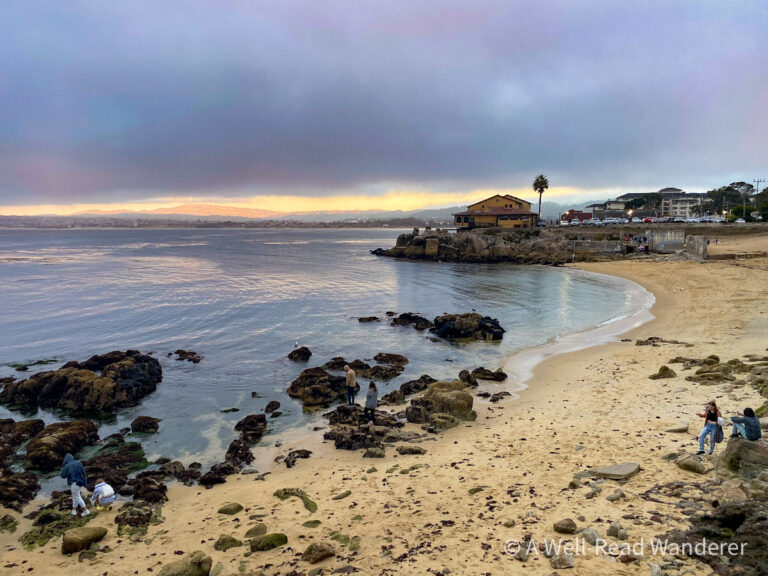
Cannery Row, Monterey: Scenery, Steinbeck, & Seafood
Along the epic seashore in Monterey, California, savvy travelers can visit an iconic location in literary history: Cannery Row. These days, it’s a popular seaside destination, but in the 1920s-30s, Monterey was a small town dominated by its sardine canning industry. During that time, it also…

The Beat Generation San Francisco: A Literary Tour
San Francisco, California is the home of the Beat Movement of the 1950s, and all the writers and poets at the forefront of that movement. In this post, you’ll discover all the best Beat Generation San Francisco sights to visit on your next trip. It is…

6 Amsterdam bookstores to fall in love with
For English speakers looking for a fun city to visit in Europe, you can’t go wrong with a trip to Amsterdam, Netherlands. It’s a breathtakingly beautiful city, and every Amsterdam street is a postcard-perfect view: canals, row houses with gabled roofs, and bicycles galore. It’s easy…

Hamlet’s Castle in Denmark: A Visit to Kronborg Slot
Did you know that Hamlet’s Castle is an actual place you can visit in Denmark? Kronborg Castle is a great literary travel destination

The Surprising F. Scott Fitzgerald Sights in Maryland
F. Scott and Zelda Fitzgerald were the Kardashians of the Jazz Age. The Fitzgeralds were the embodiment of the Flapper lifestyle that took the US and Europe by storm in the 1920s. In fact, F. Scott is even credited with inventing the term “Flapper,” and Zelda…
Leave a Reply Cancel reply
Your email address will not be published. Required fields are marked *
Save my name, email, and website in this browser for the next time I comment.
Yes, add me to your mailing list
- A Brief History Of Chateau...
A Brief History of Château d’If, France's Island Prison

Château d’If is an old island prison off the coast of Marseille . It was made legendary by Alexandre Dumas in his classic novel, The Count of Monte Cristo . It’s where his hero was wrongly imprisoned for years. Here’s our guide to the history behind this amazing monument, how to get there and what to do.
The island of If is a very small island – only three hectares in size. It’s part of a small archipelago that includes the larger island of Frioul, which is a wonderful nature reserve and home to a little fishing community.

The fortress is the only thing that has ever been built on the island of If. King Francis visited the island in 1516 and realised that it was an ideal place to build a fort to protect Marseille from an attack.
Construction began in 1524 and finished in 1531. It has three storeys, built in the shape of a square (28 metres long) protected by towers, with cover for archers and guns.
It looks imposing and acted as a deterrent, but it never actually had to play a part in defending Marseille against a military attack – which is probably a good thing. The fort wasn’t well-designed; it was built with a lot of mistakes and might have been easy to capture and/or destroy.
https://instagram.com/p/BSyFH8GBvIl/
By the 1800s, it was clear that there wasn’t a military role for the fortress to play in defending France. It was an ideal place to use as a prison though, primarily because of the fact it was an island and difficult to escape from. There are fast currents that run through the surrounding waters, which acted as a deterrent, very similar to the island prison of Alcatraz , in San Francisco .
https://instagram.com/p/BSq7EoVlmZd/
Throughout the 1800s, until the prison’s closure in 1890, thousands of political prisoners were housed here. In keeping with the time, poorer prisoners were kept in the worst conditions – in dungeons on the lower floor, full of people, hunger and disease – whilst the richer prisoners were allowed to pay for better cells on the upper floors, complete with fireplaces and proper beds. 3,500 French Protestants were put in prison here, as well as several political prisoners. Their etchings on the bricks can still be seen today.
Napoleon also kept the body of Republican Jean-Baptiste Kléber at the Château for many years, after his assassination in Cairo, because he was afraid that giving Kléber a martyr’s funeral would undermine his own power.
https://instagram.com/p/BS3kqvNFa9e/
But perhaps the castle is most well-known for its literary role in Dumas’ classic, The Count of Monte Cristo . It was published in the 1840s and was an instant bestseller. It tells the story of young Frenchman, Edmond Dantès, who is on course to marry his true love and live happily ever after. But he’s betrayed by two men and imprisoned on If for 14 years, before he makes a daring escape. He goes in search of some treasure he has heard about, and gets his revenge on the two men.
It’s still a hugely popular book, discussing how life can change for the worse at a moment’s notice: “On what slender threads do life and fortune hang!”In real life, no one is ever known to have successfully escaped from the prison.
https://instagram.com/p/BS3NO9PBLoX/
Take the time to visit both Château d’If and the neighbouring island of Frioul in the same day. Either take a picnic or eat at one of the harbour restaurants in Frioul. The paths and stone can be hard-going on the feet, so take practical footwear and lots of water in summer. You can swim on the island of Frioul, so don’t forget your towels, swimwear and suncream.
How to get there: Ferries leave from the Old Port in Marseille to the island of Frioul, stopping at Château d’If on the way. Not all the ferries stop at the fortress so make sure you check beforehand.
Opening hours: Tuesday to Sunday, 10am to 5pm (6pm from April to October). Closed Mondays.
Château d’If, Marseille
Since you are here, we would like to share our vision for the future of travel - and the direction Culture Trip is moving in.
Culture Trip launched in 2011 with a simple yet passionate mission: to inspire people to go beyond their boundaries and experience what makes a place, its people and its culture special and meaningful — and this is still in our DNA today. We are proud that, for more than a decade, millions like you have trusted our award-winning recommendations by people who deeply understand what makes certain places and communities so special.
Increasingly we believe the world needs more meaningful, real-life connections between curious travellers keen to explore the world in a more responsible way. That is why we have intensively curated a collection of premium small-group trips as an invitation to meet and connect with new, like-minded people for once-in-a-lifetime experiences in three categories: Culture Trips, Rail Trips and Private Trips. Our Trips are suitable for both solo travelers, couples and friends who want to explore the world together.
Culture Trips are deeply immersive 5 to 16 days itineraries, that combine authentic local experiences, exciting activities and 4-5* accommodation to look forward to at the end of each day. Our Rail Trips are our most planet-friendly itineraries that invite you to take the scenic route, relax whilst getting under the skin of a destination. Our Private Trips are fully tailored itineraries, curated by our Travel Experts specifically for you, your friends or your family.
We know that many of you worry about the environmental impact of travel and are looking for ways of expanding horizons in ways that do minimal harm - and may even bring benefits. We are committed to go as far as possible in curating our trips with care for the planet. That is why all of our trips are flightless in destination, fully carbon offset - and we have ambitious plans to be net zero in the very near future.

See & Do
Secret alternatives to busy marinas in the french riviera for avoiding the crowds.

The Most Beautiful Castles to Visit in Normandy, France

Best Places to Visit in France From the UK

A Guide to Sailing in and Around France

Amazing Day Trips to Take Around Corsica by Boat

Amazing Day Trips to Take Around Brittany by Boat

Why Dijon Is the Perfect French Weekend Getaway

Food & Drink
Must-visit food markets in france.

The Best Food to Eat in the French Alps

Places to Stay
The top spas to book in historic french cities.

A Guide to Sailing in Charente-Maritime, France

The Top French Dishes You Need to Try
Culture trip spring sale, save up to $1,100 on our unique small-group trips limited spots..

- Post ID: 1239843
- Sponsored? No
- View Payload
National Geographic content straight to your inbox—sign up for our popular newsletters here

The Château d'If looms over the Bay of Marseille in France.
7 Old Prisons That Are Open to Visitors
Get a glimpse of the brutalities endured behind the walls of these now defunct institutions around the world.
A wooden chair sits under a spotlight in the Texas Prison Museum in Huntsville, on display in the same unassuming manner one might see a French neoclassical armchair in the Metropolitan Museum of Art. Instead of guilloches and pearls, this particular chair is adorned with leather straps, which were used to restrain the wrists and ankles of hundreds of inmates while electricity passed through their bodies. Decades after Old Sparky was retired, visitors can see the unsettling display for themselves.
Prisons, like other historical sites, provide a unique window into a country’s political history, views on crime and punishment, and laws governing freedom and human rights. Each year millions of people trickle through the shadowy halls of decommissioned prisons around the world to learn their grim histories.
Robben Island, South Africa
Located off the coast of Cape Town , this UNESCO World Heritage site has served as a leper hospital, military base, and most infamously, a maximum security prison for political prisoners during apartheid, South Africa’s state-sanctioned system of racial segregation. Robben Island’s somber history finally came to an end in the 1990s, when South Africa’s oppressive regime was dismantled and political prisoners were freed. Anti-apartheid revolutionary Nelson Mandela , who served 18 years on Robben Island, went on to become the country's first black president in its first fully representative democratic election in 1994.
Lesser known fact: Robben Island is home to a colony of African penguins, an endangered species.
How to visit : Boats travel from Cape Town to Robben Island three times a day (four during peak season), and rides take about 30 minutes each way. Tours last around four hours and cost about $23 for adults and $13 for children.

Old Melbourne Gaol, Australia
Between 1842 and 1929, Old Melbourne Gaol housed Australia ’s most notorious criminals, such as bushranger Ned Kelly and serial killer Frederick Bailey Deeming. During its tenure, 133 prisoners were executed by hanging and buried in unmarked graves in the prison yard. One of the gaol’s most notable exhibits is its collection of death masks . After a prisoner was executed, his head was shaved, and plaster was applied to the face and head in order to create a mask. Historians believe the state may have created these as a power symbol—a representation of its triumph over crime. The masks were also used in the pseudoscientific study of phrenology, which held that the physical formations of the skull and face were indicative of a person’s character.
Lesser known fact: A women’s cell block wasn’t constructed until late 1864. Prior to this, women, children, and men were housed together.
How to visit: Old Melbourne Gaol is open daily from 9:30 a.m. until 5 p.m., except on Christmas Day and Good Friday, and can be easily reached via public transit . Adult admission is $19, and for children admission costs $10. Visitors should plan to spend at least one and a half hours at the site.
Alcatraz, United States
One of the most notorious prisons in the United States, the Rock was originally used as a military fortress and prison in the 1850s, and later operated as a federal penitentiary from 1934 to 1963. The prison housed prominent inmates like Al "Scarface" Capone and Machine Gun Kelly. Its secluded location surrounded by the chilly waters of the San Francisco Bay were thought to render the prison inescapable. In 1962 inmates John Anglin, Clarence Anglin, and Frank Morris tested this theory when they tucked papier-mâché heads into their beds, broke out of the main prison, and escaped the island on a raft made of raincoats. Their fate remains unknown to this day.

Alcatraz Island sits in the San Francisco Bay in California.
Lesser known fact: Each year hundreds of athletes participate in the Escape From Alcatraz Triathlon in San Francisco, a one-and-a-half-mile swim, 18-mile bike ride, and eight-mile run.
How to visit: All access to the island is through Alcatraz Cruises , which operates out of Pier 33 in San Francisco. Day and night tours are offered year-round, with the exception of some holidays. Tickets often sell out, so book in advance. Plan on spending around two hours for a full tour.
Elmina Castle, Ghana
This UNESCO World Heritage site was built by the Portuguese in 1482 on the Gulf of Guinea and is believed to be the location where Europeans first made contact with sub-Saharan Africans. Occupied by several colonial powers throughout the centuries, this trading post eventually became a significant stop in the transatlantic slave trade. Tens of thousands of Africans were captured and detained, and eventually passed through Elmina’s “door of no return” to be loaded onto slave ships and sold throughout Europe and its colonies.
Lesser known fact: Elmina Castle is one of the oldest European buildings located outside of Europe.
How to visit: Elmina Castle is easily accessible by taxi from the historic city of Cape Coast in the central region of Ghana, about three hours west of Accra. The museum is open from 9 a.m. to 4:30 p.m. daily. Admission is $10 for non-Ghanaian adults and two dollars for non-Ghanaian children.
Tuol Sleng, Cambodia
When the genocidal Khmer Rouge took power in Cambodia in 1975, this former high school was converted into Security Prison 21, a detention center that facilitated the torture and murder of thousands of people. Thirty minutes south of the prison, mutilated bodies of men, women, and children were dumped in mass graves in the Choeung Ek killing fields. After the fall of the regime in 1979, Tuol Sleng was turned into a museum to remember the victims of the genocide and the horrors inflicted by the Khmer Rouge, responsible for the deaths of an estimated 1.7 million people during its reign.

Visitors walk through one of the exhibitions in the Tuol Sleng Genocide Museum in Phnom Penh, Cambodia.
Lesser known fact: Actress Angelina Jolie is directing a new Netflix film based on the memoir First They Killed My Father : A Daughter of Cambodia Remembers by human rights activist Loung Ung, who lived under the Khmer Rouge as a child. The film is set for release in late 2016 in both English and Khmer.
How to visit: Tuol Sleng is located in the capital city of Phnom Penh and can be easily reached by tuk-tuk or taxi from the city center. Drive another 30 minutes south to the Choeung Ek Genocidal Center for a sobering history lesson.
- Nat Geo Expeditions
Devil’s Island, French Guiana
This penal colony located off the picturesque Atlantic coast of French Guiana was constructed in the early 1850s under the orders of French emperor Napoleon III. For nearly a century, the colony, which spanned three islands in addition to mainland facilities, housed tens of thousands of convicted criminals and political prisoners who were banished to serve out their sentences doing hard labor. Prisoners were assigned to work camps stretching across the islands, where they spent long, strenuous hours clearing jungle, building roads, and constructing their own cell blocks. Shark-infested waters, unforgiving terrain, and the threat of tropical disease made hopes of escaping the prison’s brutal conditions a deadly task.
Lesser known fact : After 11 years on Devil’s Island, prisoner Henri Charrière escaped to Venezuela on a raft made of coconuts. His autobiography inspired the 1973 movie Papillon , starring Steve McQueen and Dustin Hoffman.
How to visit : From the capital city of Cayenne, visitors can take an hour-long bus ride to the town of Kourou. From Kourou dock, a number of boat companies offer daylong tours of the islands.
Château d’If, France
This 16th-century fortress turned prison was made famous by Alexandre Dumas’s 1844 revenge novel, The Count of Monte Cristo . The chateau’s isolated location among the strong currents of the Bay of Marseille made it an ideal location to discard religious and political prisoners. Its imposing stone walls housed prisoners in cramped, unsanitary conditions for nearly three centuries until it was closed in the late 19th century and opened to the public as a tourist attraction.
Lesser known fact: Edmond Dantès, the vengeful protagonist of Dumas’s novel, did not actually exist.
How to visit: Take a 20-minute ferry ride from the Old Port of Marseille to Château d’If . The island’s operating hours vary seasonally, so check schedules before you go. Citizens of the European Union and children under 18 get free admission to the monument itself, and adults pay about $6.
Related Topics
You may also like.

Some U.S. national parks are trying to go carbon-free. What does that mean for visitors?

How destinations are helping LGBTQ+ visitors travel with pride
Free bonus issue.

A taste of Corfu, surprising Italian influences and generations-old recipes

How to plan a family summer trip to the Swiss Alps

A taste of North Macedonia, from flaky burek to rakija and farmhouse cheeses

10 days in Pennsylvania: take a trip through the history of the USA

Why midlife looks different for millennials
- Environment
- Perpetual Planet
History & Culture
- History & Culture
- History Magazine
- Mind, Body, Wonder
- Paid Content
- Terms of Use
- Privacy Policy
- Your US State Privacy Rights
- Children's Online Privacy Policy
- Interest-Based Ads
- About Nielsen Measurement
- Do Not Sell or Share My Personal Information
- Nat Geo Home
- Attend a Live Event
- Book a Trip
- Inspire Your Kids
- Shop Nat Geo
- Visit the D.C. Museum
- Learn About Our Impact
- Support Our Mission
- Advertise With Us
- Customer Service
- Renew Subscription
- Manage Your Subscription
- Work at Nat Geo
- Sign Up for Our Newsletters
- Contribute to Protect the Planet
Copyright © 1996-2015 National Geographic Society Copyright © 2015-2024 National Geographic Partners, LLC. All rights reserved

One day exploring Îles du Salut, French Guiana
Have you seen the film Papillon? Either the Steve McQueen/Dustin Hoffman classic or the 2018 remake? It’s about a serial thief who is sent to the French penal colony on Îles du Salut, off the coast of French Guiana, adapted from the memoirs of real-life inmate Henri-Charriere.
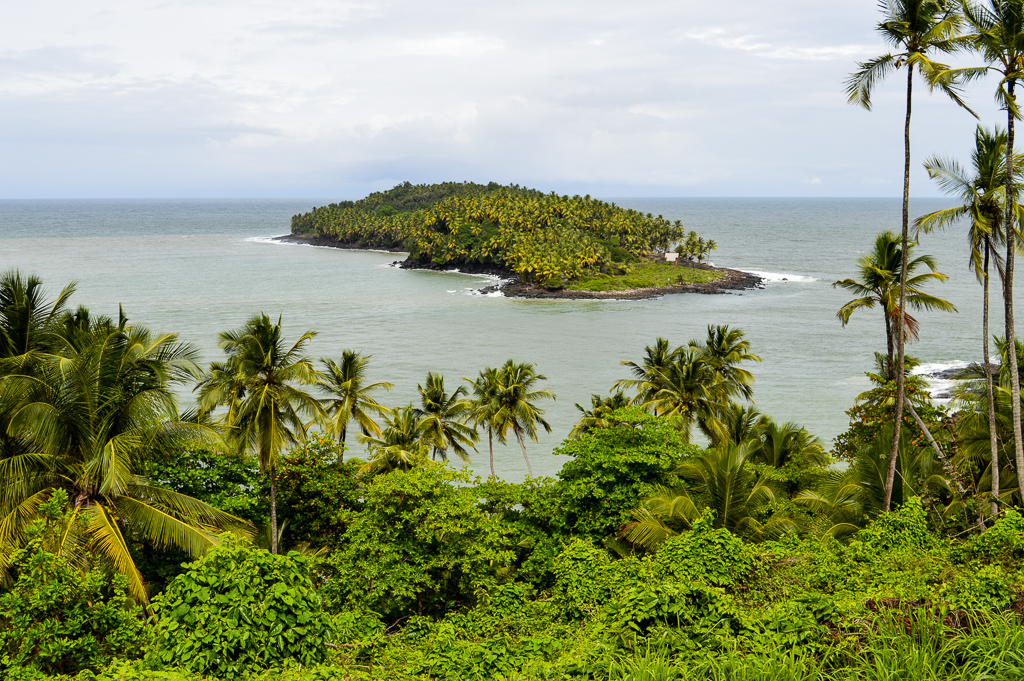
There are in fact three islands, to the ironically called, Salvation Islands. The largest is Ile Royale, and is not often visited, except by cruise ships and Saint Joseph Island and Devil’s Island (Îles du Salut) which are completely barred from tourists. We spent the day exploring Ile Royale as part of our voyage onboard the Viking Sea.
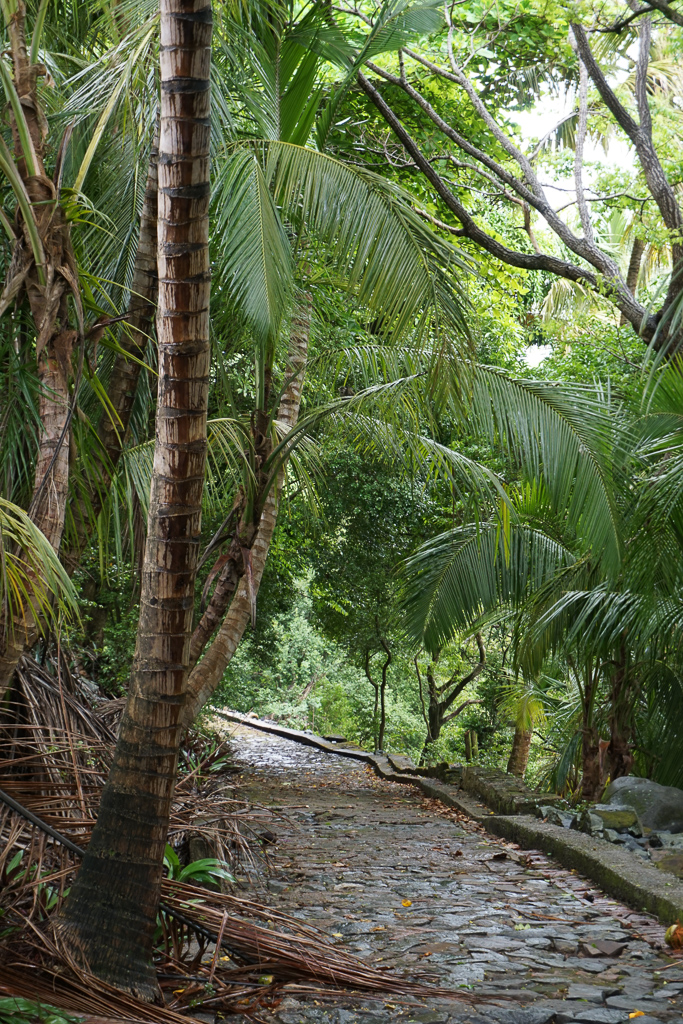
French Guiana was the only South American colony for France. The French were looking for gold like everyone else, but all that they found on these islands was jungle and malaria.
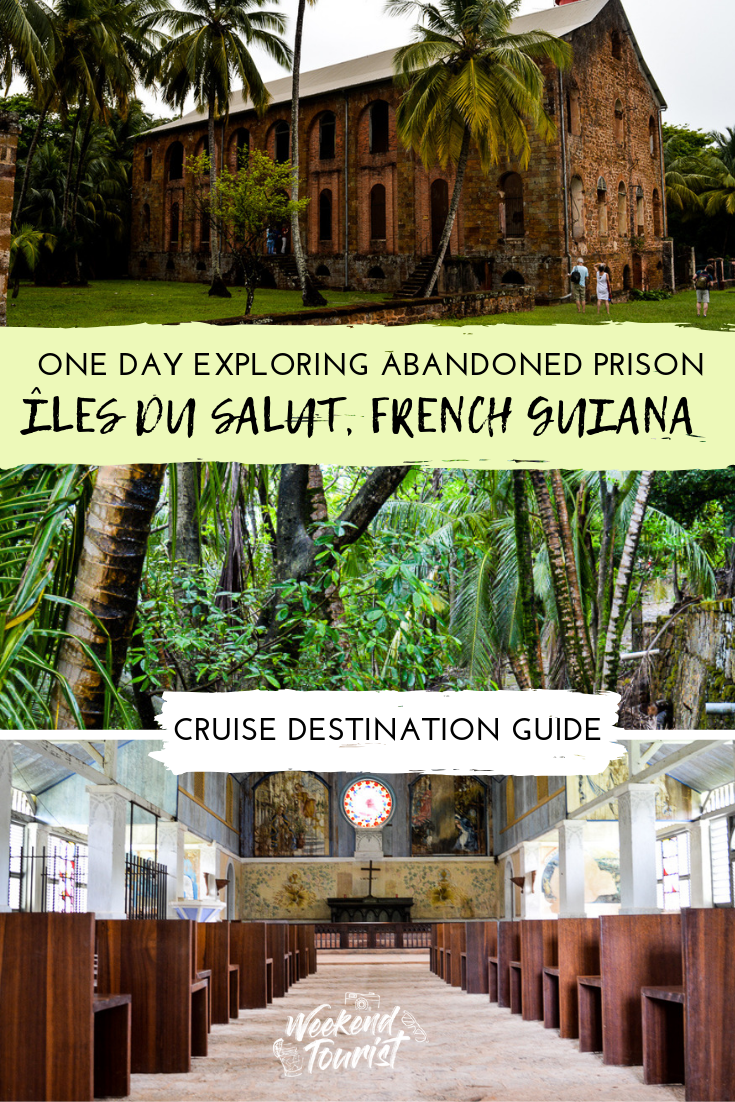
French Emperor Napoleon III deemed that the best use for the islands was as a place of exile for political prisoners. Napoleon realised that his government was housing 6,000 political prisoners in disease-ridden floating jails. Rather than spoil the view for Parisians, he had the prisoners sent to Guiana. And from 1852, the islands became one of the most notorious prisons in history.
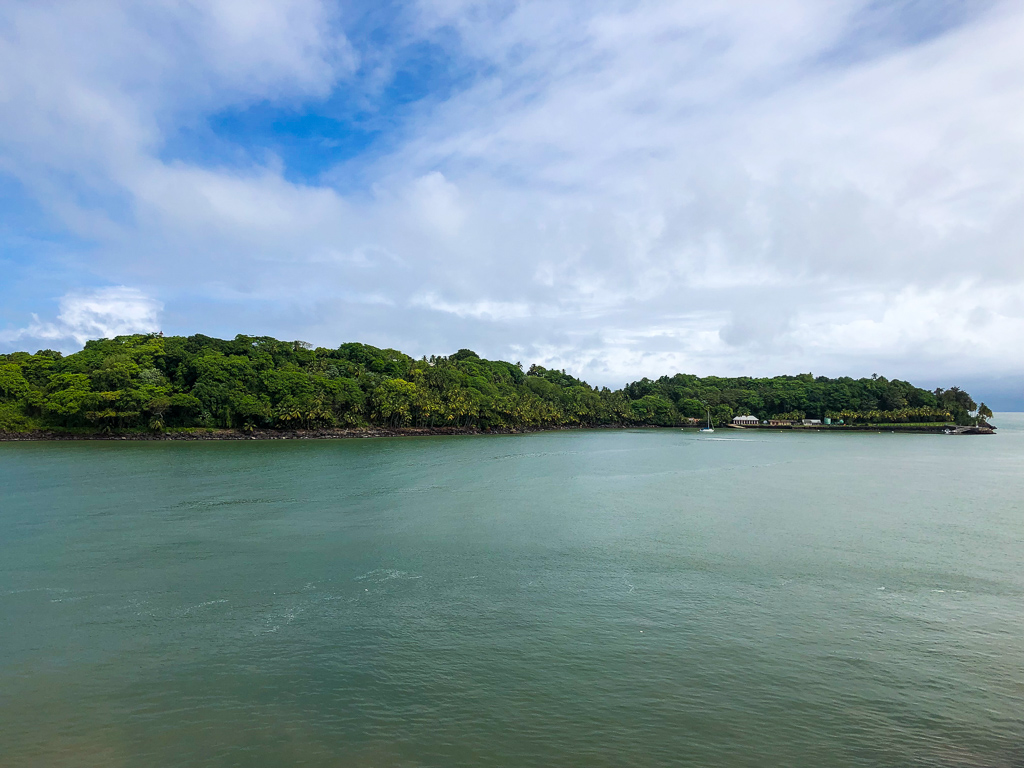
Often people who were transported here, never returned and even if they lived to see the end of their sentence, they didn’t have the funds to return to France, so worked out their days on the island. As a prison, life was pretty desolate. The islands were used as a prison until after WWII in 1947 and some 70,000 prisoners stayed on the island across its life span, issued with red striped shorts and a straw hat. Now it is abandoned, looked after by the French National Trust.

Saint Joseph Island was considered the worst prison, home to solitary confinement, where prisoners were not allowed to speak for years at a time and were often driven insane. Devil’s Island itself, a tree covered rock and a former leper colony, was home to the most notorious criminals and is completely off-limits today. It’s estimated that there were 50,000 escape attempts from the prison as a whole. Most were failures.
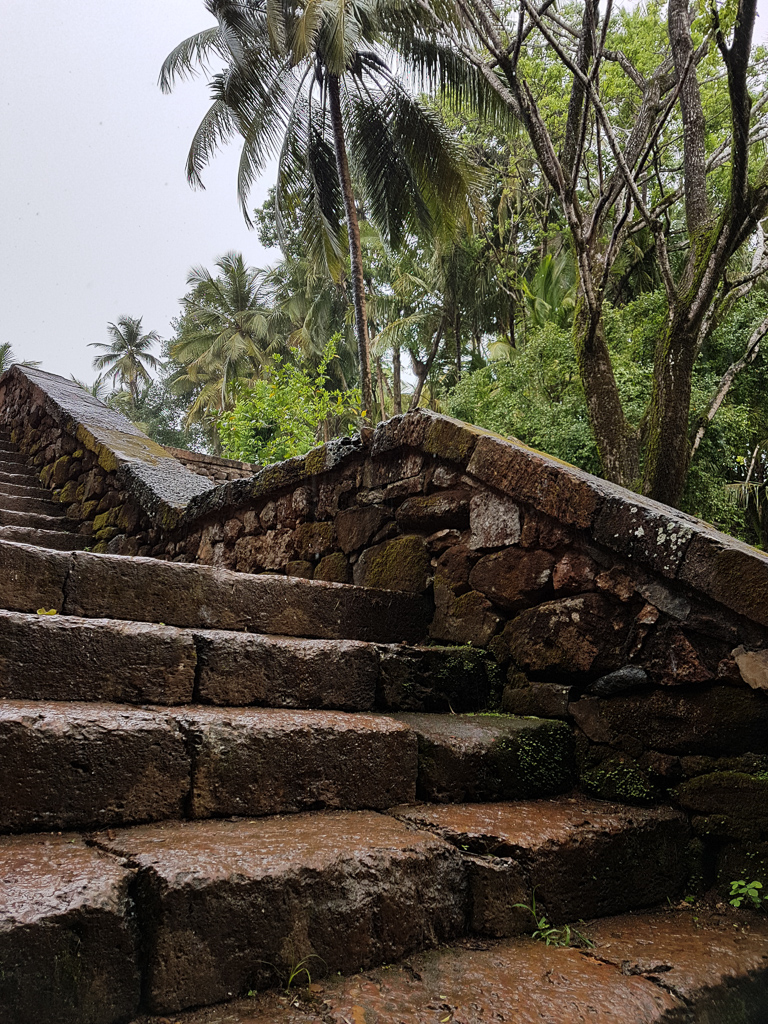
We caught the tender boats from the Viking Sea ashore and were able to explore Ile Royale on foot independently. The island was home to the prison guards’ quarters, who lived here with their wives and children; the hospital; the warden’s house; office; plus the guard’s mess hall.
Our walk around the island starts with Musée du Bagne, in the former Director’s home which has lots of information about life in the prison. From here we walked upward, there’s both a set of steep steps which are slippery when wet, or you can make your way up the sloping roadway to the top.
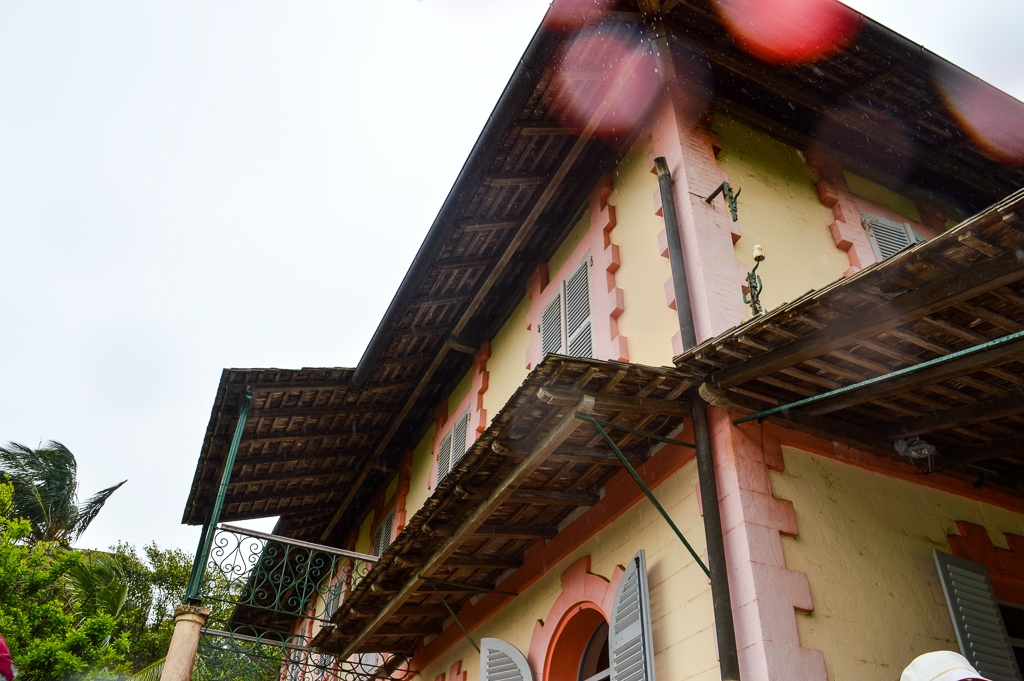
At the summit, the prison buildings are spread out around the perimeter of a large grassy courtyard. We headed first for the prison’s chapel built by hand by the prisoners around 1855. Inside the wooden church, we could just see from the closed gates at the entrance, the murals painted by convict forger, Francis Lagrange or ‘Flag’. He painted daily life, escapism and even erotica on the wall, and kept up the forgery on behalf of requests from prison officers.
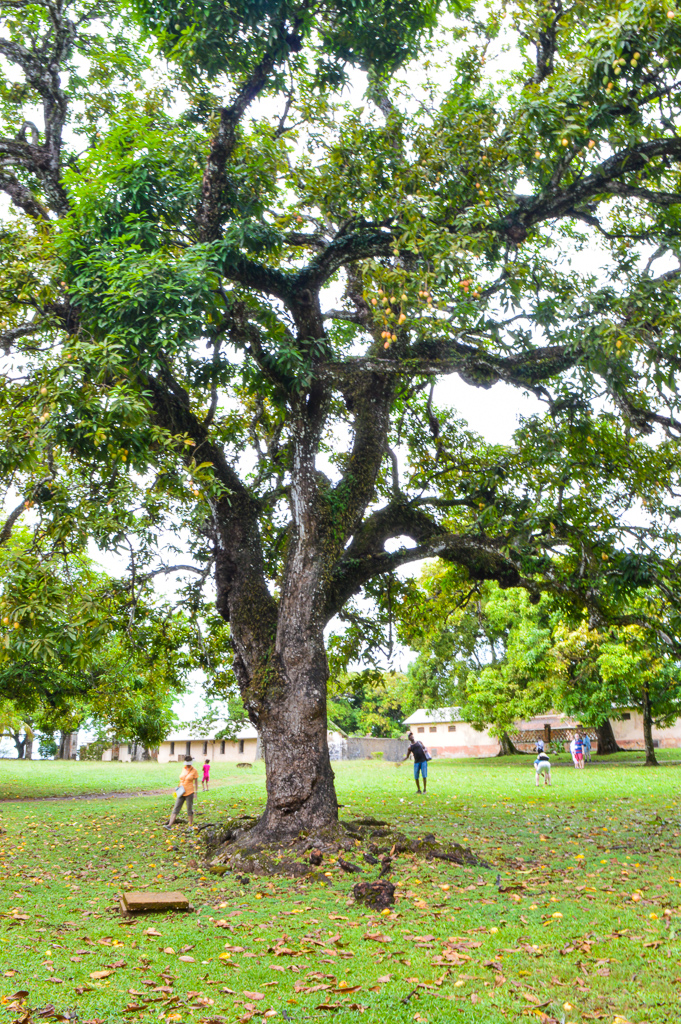
Following the church, the hospital is the largest building on the island and was designed for military personnel stationed on the island rather than the prisoners. Occasionally wealthy citizens from the mainland would come to the hospital to convalesce – heaven knows why? The lighthouse, now automatic, was once operated by a convicted mechanic.
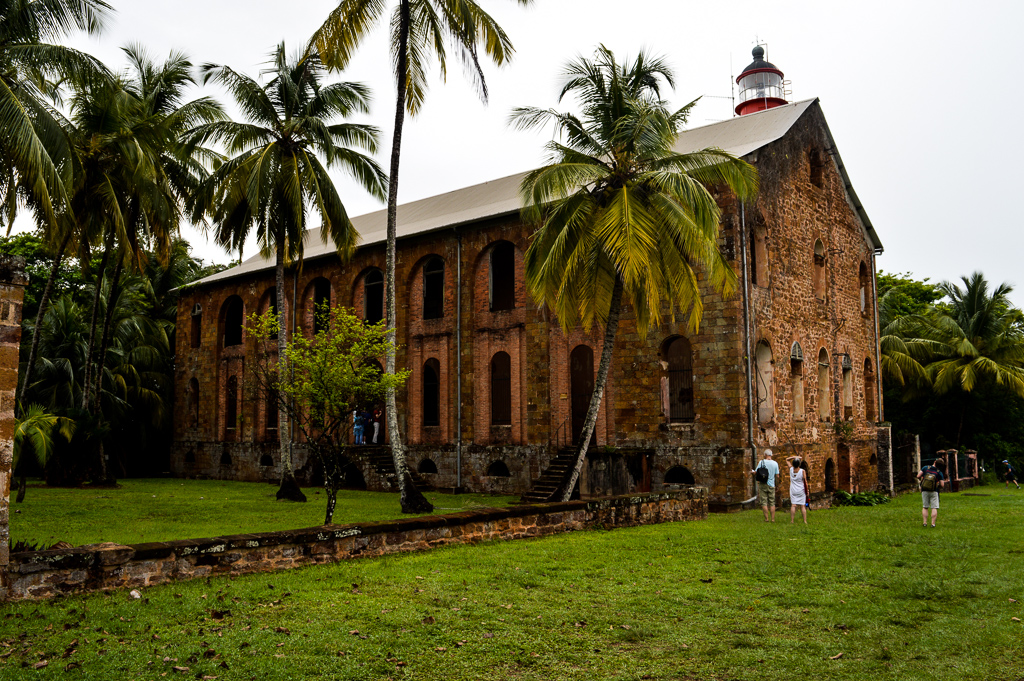
Saint Joseph Island housed most of the prisoners in solitary confinement, but there was a cell block dedicated solitary on Ile Royale. Here they lived on a diet of bread and soup every three days and some remained in solitary for years; each cell not much wider than the width of two outstretched arms.
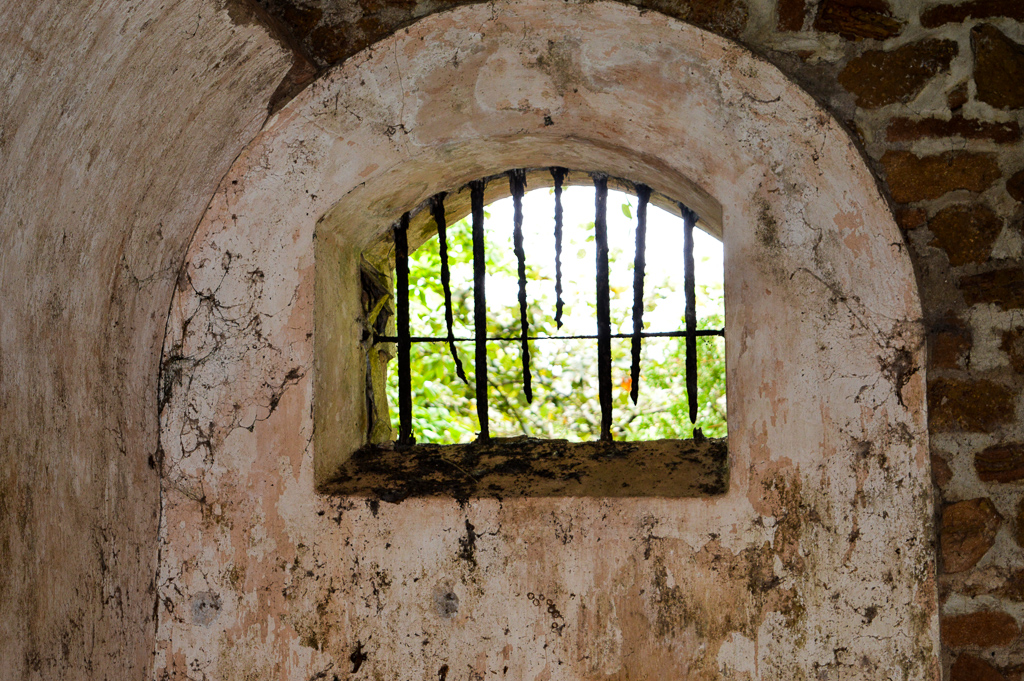
There were not many other tourists the day we visited, principally just passengers from the Viking Sea and there are not many people actually on the island – mainly the staff running the guesthouse and some gendarmes now stationed in the guard’s quarters. I read after that the islands are in the pathway of a nearby rocket path and gendarmes are principally in charge of ensuring that the island is evacuated when a launch is expected.
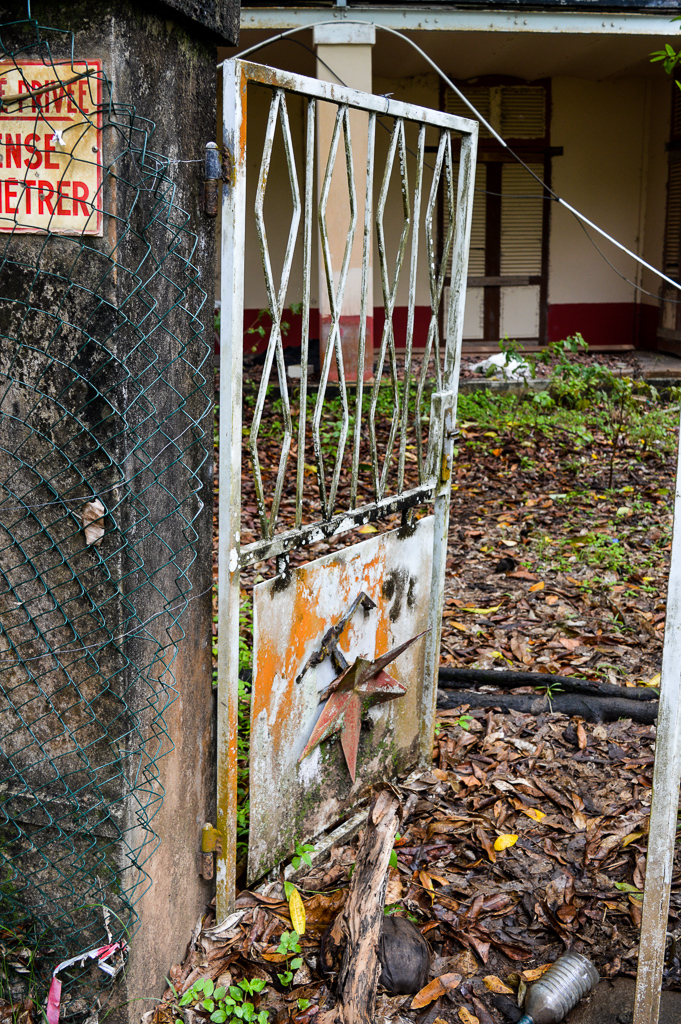
The mess hall now houses a small guesthouse, restaurant, and shop. It’s big enough for a rest stop, but I’m not sure if it is the sort of place I would want to stay. A lot of buildings are crumbling, home to monkeys and the jungle clawing its way back in. It’s an interesting place, but you wouldn’t want to get left behind.
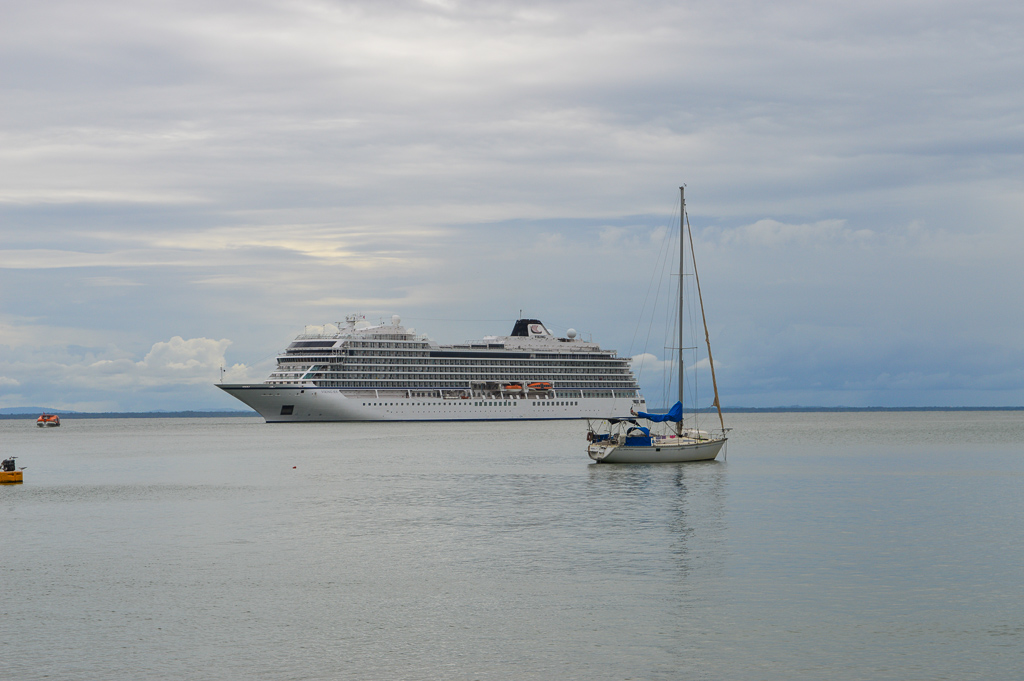
Leave a Reply Cancel reply
Your email address will not be published. Required fields are marked *
Save my name, email, and website in this browser for the next time I comment.
This site uses Akismet to reduce spam. Learn how your comment data is processed .
Devil's Island - See Old French Penal Colony on South America Cruise
JODY AMIET / Stringer / Getty Images
Devil's Island is one of three Salvation Islands used by the French as penal colonies from the mid-1800s until after World War II. Tourists are not allowed on Devil's Island but instead can tour the old prison facilities on Isle Royale, which is just a short distance away.
Devil's Island may be an unusual port of call, but this old French penal colony is fascinating and was well-depicted in the Steve McQueen movie, "Papillon". Everyone on our South American cruise on the Seven Seas Mariner looked forward to our visit, and we were not disappointed. The day was very rainy, but that didn't stop many of us from taking the tender ashore to explore Isle Royale and get a close look at Devil's Island. Its look and history is as horrid as depicted in the movies.
Devil's Island in the Salvation Isles of French Guiana
Linda Garrison
Cruise ship passengers and other tourists are not allowed to visit Devil's Island, which is one of the three Salvation Islands, also known as Iles du Salut, of French Guiana off the coast of South America. The three Salvation Islands are named Devil's Island, St. Joseph Island, and Isle Royale, and are located about 10 miles from the mainland of South America.
Cruise ships sailing between the Caribbean and the Amazon River or between the Caribbean and Rio de Janeiro often stopover at the Salvation Islands so that their guests can learn about the history of the island group and see Devil's Island a short distance away.
It was a rainy morning when the Seven Seas Mariner anchored at Isle Royale in the Salvation Isles (Iles du Salut) off the coast of French Guiana. Devil's Island is just a short distance away.
Isle Royale Hotel near Devil's Island
Isle Royale is one of the three Salvation Islands, the most famous of which is Devil's Island.
Auberge des Îles du Salut is the Isle Royale Hotel.
Barracks Building near Devils Island
One of the barracks buildings on Isle Royale near Devil's Island.
Devils Island - South America Cruise Ship Port of Call
A look at Devil's Island from Isle Royale. The two Salvation Islands had different types of prisoners and were connected with a basket on a pulley system.
Isle Royale in the Salvation Islands Off the Coast of South America
The Salvation Islands are picturesque tropical islands today, but they were devoid of these lovely palm trees when the islands were used for prisoners.
Isle Royale - South America Cruise Ship Port of Call
Warden's pool - devils island - south america cruise ship port of call.
The waters surrounding the Devil's Island French penal colony are filled with sharks. The prison warden had the inmates dig this "swimming pool" near the shore so that his family could swim safely.
Isle Royale Swimming Pool and Devil's Island
Isle royale water reservoir - devil's island port of call.
This fresh water reservoir was dug by the prisoners using teaspoons. Yes, this large pool was dug one small spoonful at a time.
Iguanas on Devil Island
For iguana lovers - here's another good iguana photo.
Devils Island Prison Cell
In the 100+ years the Salvation Isles were used as a French penal colony, about 80,000 prisoners were sent to the islands. Only 30,000 lived to tell about it.
Devil's Island Prison Cell
Devil's island prisoner restraints.
Even the hospital had restraints to lock the prisoners down at night. This picture was particularly sobering for me.
Devils Island Hospital and Jail House
Devils island - prisoners' toilets.
These toilets certainly don't compare well with the bathrooms on the Seven Seas Mariner! We were happy to go back to the luxury of our cruise ship afterwards.
Devils Island Jail House
Hotel cottages on isle royale near devil's island, church on isle royale near devils island, devil's island agouti, devil's island - south america cruise ship port of call, st. joseph's island in the salvation islands, rainy day on devil's island.
It was a very rainy day when the Seven Seas Mariner visited Devil's Island. We all had to use our blue and white ship's umbrellas.
Seven Seas Mariner Off the Coast of Devils Island
Tour Devil's Island in French Guiana
48 Hours in Marseille: The Ultimate Itinerary
8 Must-Visit Islands in the Galapagos
Mediterranean Cruise Maps
Moscow - Russian Rivers and Waterways Port of Call
Top Cruise Ports in the Eastern Caribbean
Disney Magic - Tour and Profile
The Best Beach in Every State
Nassau: Cruise Ship Port of Call in the Bahamas
13 New Ocean Cruise Ships in 2018
Cubas Capital City of Havana
The 26 Best Washington, D.C. Monuments and Memorials
18 Most Beautiful Islands in the World
Top 50 Places to See in South America
22 Best Things to Do in Belize
The Top 15 UNESCO World Heritage Sites in France
The Official Tour of Alcatraz Island and Prison
Step back in time and experience the legendary island that has been a Civil War fort, a military prison and one of the most notorious federal penitentiaries in US history. This memorable tour includes: 45 minute audio presentation “Doing Time: The Alcatraz Cellhouse Tour,” featuring actual correctional officers and prisoners who lived and worked on the Island; orientation video by Discovery Channel; ranger and docent tours; historic gardens and abundant wildlife.
CELLHOUSE AUDIO TOUR
No one can tell the Alcatraz tale like the men who actually lived it. The captivating Alcatraz Cellhouse Audio Tour brings history alive through the actual voices of the correctional officers and inmates who lived on the island during the infamous Federal Penitentiary era.
Hear both sides of life in the island prison including such famous events as escape attempts, “The Battle of ’46”, food riots, and surviving solitary confinement.
The Cellhouse Audio Tour is available in Dutch, English, French, German, Italian, Japanese, Korean, Mandarin, Portuguese, Russian and Spanish.
GARDENS OF ALCATRAZ
From the military to the penitentiary era, plants softened the Rock for those who called Alcatraz home. Through gardening, island residents created beauty in a place focused on defense, punishment, and confinement. The families of the guards enjoyed tea parties in the gardens, and gardening became a welcome pastime. For trusted inmates, the gardens were an escape from daily prison life. Even today, the thriving gardens are a stark contrast to the somber prison.
After closure of the prison in 1963, many plants survived decades without care. These survivors are excellent choices for gardeners in the Bay Area or other Mediterranean climates. Since 2003, The Garden Conservancy has been working in partnership with the Golden Gate National Parks Conservancy and the National Park Service to restore these wonderful gardens and to share the stories with visitors.
Join a garden docent for an up-close look at the restored historic gardens of Alcatraz. Learn about the softer side of the Rock and how gardens made life tolerable for residents of the barren island. Tours leave the Alcatraz dock at 9:30 am every Friday and Sunday.
GUIDED TOURS
Join the island staff for a guided walking tour of Alcatraz Island. Programs are offered throughout the day and generally start either at the dock or lighthouse. Topics may include Famous Inmates, Escapes, Hollywood’s Rock, 200 Years of Alcatraz History, and Fortress Alcatraz. Some programs even take visitors into restricted areas of the island.
Guided tours generally last 45 minutes to an hour, and may involve walking moderate distances.
Tours and times vary daily, so check the Program Board when you arrive on the island dock. No reservations are required, and all programs are free.
ALCATRAZ: STORIES FROM THE ROCK
Alcatraz: Stories From the Rock takes viewers on a journey through the Island’s many chapters: its early role as a military fortress, the famous federal penitentiary years, the Indian occupation that altered the course of history, and finally the popular National Park and wildlife refuge it is today.
Alcatraz stands as a powerful symbol of protection and change. The film explores Alcatraz as it began, as it evolved, and as it stands today and allows viewers to discover the many layers that make it an incredible time capsule of history and human drama.
VIDEO: WE HOLD THE ROCK
The occupation of Alcatraz Island from 1969 to 1971 by “Indians of All Tribes” changed the course of U.S. and American Indian history, and brought world-wide attention to the plight of American Indians. The award winning video/exhibit, “WE HOLD THE ROCK,” produced by the National Park Service and the Golden Gate National Parks Conservancy, is shown continually in the China Alley exhibit behind the main theater area near the dock.
ALCATRAZ AND THE AMERICAN PRISON EXPERIENCE
“Alcatraz and the American Prison Experience,” a major interpretive exhibit, explains the place of Alcatraz in the evolution of prisons in America from Colonial days to the present. Produced in partnership with the federal Bureau of Prisons, the exhibit also looks at family life on Alcatraz and trends in American penology. The exhibit is housed in two historic fortress storerooms in the China Alley display area near the dock.
- No Search data
- Western turkey
- 1. [AF1] southern african circuit
- 2. [NL1] newfoundland & labrador
- 3. [CA3] the five stans
- 4. [MCSP] south pacific explorer
- 5. [MCUP] untouched pacific islands
- 6. [MCWA] a west african odyssey
- 7. [GY1] guyana, suriname & french guiana
- 8. [MCIO] indian ocean islands
- 9. [EG3] classic egypt
- 10. [GS8] the arab gulf states
- How We Travel
- Tour Styles
- Tour Leaders
- Our Partners
- Senior Tours
- e-Newsletter Archive
- Newsletter Subscribe
- Photo Contest
- Tour Safety
- Terms and Conditions
- Cancellation Policy
- Single Supplement Information
- Travel Insurance
- Frequently Asked Questions
- Passport and Visas
- Travel Tips
- Privacy Policy
Small Group French Guiana Tours


- South America
- French Guiana
1 Tour Options
Guyana, suriname & french guiana tour code: gy1.
This is the announcement bar for Poornima to test the Close Button. It will expire May 31 2024.
- Pre-Cruise FAQ
- Onboard FAQ
- Post-Cruise FAQ
- Cruisetours FAQ
- Special Offers Sign Up
- Cruise Deals
You have been logged out
Your window will update in 5 secs
Explore the Penal Colony of Devil's Island
Located off the northern coast of French Guiana, Devil's Island has an eerie reputation earned over the course of 100 years, when it served as a penal colony for the government of France. If you want to learn about extreme history during a South American cruise , this is a destination you won't want to miss.
Devil's Island was first used as a prison in 1852, when Emperor Napoleon II chose the isle as the site of a new penal colony intended to house hardened criminals and political prisoners. Over time, the island held as many as 80,000 people, who were fed minimal amounts of food and subjected to hard labor during their prison terms before the prison closed in the middle of the 20th century. In particular, the prison is famous for holding Alfred Dreyfuss, a French military officer whose Judaism led him to be falsely accused of treason, and Henri Charriere, a thief who wrote a famous book about his escape from the craggy outcropping.
During your cruise, you can enjoy several South American shore excursions on Devil's Island. At the prison headquarters on Ile Royale (an isle near Devil's Island), you can explore prison cells and haunting artifacts - not to mention the rock swimming pool the warden built using convict labor. The prison director's house offers a stark contrast to the meager conditions in the cells. The luxurious structure is perched on top of a hill, providing visitors with gorgeous views of the surrounding area. Today, the house serves as a museum about the history of the penal colony.
When you take a boat to Devil's Island itself, you will marvel at the cliffs that rise 131 feet above sea level. After you disembark from your launch ship, you can walk through the abandoned prison and spot the turtles, monkeys, agoutis and birds that now make their homes there.
- Share full article
Advertisement
Supported by
Pope’s Visit to Art Exhibition in Prison Is a First for Venice Biennale
Incarcerated women serve as guides to the show, which reflects Pope Francis’ longtime commitment to society’s marginalized people.

By Elisabetta Povoledo
Reporting from Venice and Vatican City
Landing by helicopter at a women’s prison where the Vatican has mounted its pavilion for the Venice Biennale international art exhibition, Pope Francis on Sunday told the women incarcerated there that they had a “special place in my heart.”
“Grazie,” one woman called out. Others applauded.
Many of the women had participated with artists in creating works that hang throughout the prison for the exhibition, titled “With My Eyes.” Francis, the first pope ever to visit — if briefly — a Venice Biennale, said that it was “fundamental” for the prison system “to offer detainees the tools and room for human, spiritual, cultural and professional growth, creating the conditions for their healthy reintegration.”
“Not to isolate dignity, but to give new possibilities,” Francis said to applause.
Over the decades, countries participating in the Biennale — the world’s principal showcase for new art — have used deconsecrated churches, former beer factories, water buses and various other sites to display their art, but this was the first time a prison was selected.
That made the project “more complex and more difficult to implement,” Bruno Racine, the director of two venues of the Pinault Collection in Venice and a co-curator of the Vatican Pavilion, said in an interview. But the setting is consistent with Francis’ message of inclusivity toward marginalized people, he added.
The Vatican project has received an overwhelmingly positive public reception, but it has not been without controversy. Some critics raised ethical concerns about the intersection of powerful institutions like the Vatican and the Biennale with the limited autonomy of imprisoned women. Others suggested that the Vatican, in mounting the show, was complicit in a penal system in which overcrowding remains a serious issue .
Still others demanded that the pope request pardons or at least reduced sentences for any women who were incarcerated because they had responded violently to domestic abuse.
“I don’t think the Vatican has the power to have any influence over Italian justice,” Mr. Racine said of that idea.
While the Vatican has not publicly responded to the critiques, Francis has been consistently outspoken about domestic abuse, saying in 2021 that there was something “almost satanic” about the high number of cases of domestic violence against women.
He has also been a vocal advocate of prison reform, denouncing overcrowding and often meeting with inmates during his travels.
On Sunday, Francis said that prison was “a harsh reality, and problems such as overcrowding, the lack of facilities and resources, and episodes of violence give rise to a great deal of suffering there.” But he said prison could also be a place where people’s dignity could be “promoted through mutual respect and the nurturing of talents and abilities, perhaps dormant or imprisoned by the vicissitudes of life.”
The pope described his artistic vision to artists he called to the Sistine Chapel last year , telling them to “think of the poor and to ensure that art went into the peripheries,” the Vatican’s culture chief, Cardinal José Tolentino de Mendonça, said earlier this year. On Sunday, Francis told artists involved with the Vatican project that “the world needs artists.”
The curators, Mr. Racine and Chiara Parisi, of Centre Pompidou-Metz, the French museum, selected a handful of artists to work with the incarcerated women to create works that are scattered through the prison.
One, a 1965 serigraph featuring the word Hope backward, was hung over the door of the prison canteen, where about a quarter of the 80-odd inmates who agreed to serve as guides to the show first meet visitors. The serigraph was created by the artist Corita Kent, a former nun and an activist for social justice who died in 1986.
The Lebanese artist Simone Fattal transcribed poems and reflections by the incarcerated women on lava slabs that line a brick corridor: “I thought I was suffocating.” “I often think of my family.” “I am so sad.”
In another room were small stylized paintings by the French artist Claire Tabouret that were based on family photos the women had given her.
Visitors get only a brief glimpse of penitentiary life, but during the tour a short film, directed by Marco Perego and starring his wife, the actor Zoe Saldaña, shows the conditions inside in bleak black and white: shared rooms, shared showers, little privacy. Both inmates and professional actresses acted in the film, Mr. Racine said.
This is the third time the Vatican has participated in the Biennale: In 2013 and 2015, it was among many participants at the Arsenale, one the fair’s main venues. And for the 2018 Architecture Biennale, the Vatican built a series of chapels, “for believers and nonbelievers alike,” that can still be visited .
On Sunday, the pope greeted the inmates of the Giudecca prison individually in an inner courtyard. Some gave him flowers, and others pressed envelopes and notes in his hands.
Giovanni Russo, the head of the Department of Penitentiary Administration in the Italian Ministry of Justice, told reporters at a Vatican news conference in March that the women who participated in the project were entitled to unspecified benefits. While the Vatican Pavilion was unique, he said, nearly all of Italy’s 190 penitentiaries had “artistic projects” of some kind or another, involving more than 20,000 volunteers.
Visitors to the pavilion must book in advance, and time slots have been filling up fast.
It’s not the first time that the inmates at the prison have participated in major art projects. Two years ago, the French artist Pauline Curnier Jardin worked with inmates to make a film and paint a large common room where the women meet visitors twice a week. The walls are now a soft purple, decorated with stylized leaves and figures designed by the inmates during a series of workshops with the artist.
After the Biennale closes in November, the artworks in “With My Eyes” will be removed, Mr. Racine said. But Ms. Curnier Jardin’s soothing additions will remain.
Elisabetta Povoledo is a reporter based in Rome, covering Italy, the Vatican and the culture of the region. She has been a journalist for 35 years. More about Elisabetta Povoledo

IMAGES
COMMENTS
Over the years, more than 80,000 men were transported to Devil's Island penal colony, coming from all walks of life. One of the most famous was French army captain Alfred Dreyfus, who was found guilty of treason, stripped of rank and honor, and sent to prison. The prisoners were located according to status. The least threatening criminals were ...
A QUIET GEM. "Naturaliste Tours is a great way to get a glimpse of the natural bushland and coastal areas inside the large national park (2/3 of the island) as well as seeing the farmlands and community. Our wonderful guide Linda is a "local", of 10 years standing, is passionate about the island and has a sound understanding of the need to ...
One of the most well-known inmates was Alfred Dreyfus, the Jewish-French officer wrongly accused of treason, who spent four years incarcerated at a notorious prison there called Devil's Island.
Made famous by French writer Alexandre Dumas, the Chateau d'If is the iconic Count of Monte Cristo prison. ... After 14 years at the Chateau d'If, Dantès escapes from the island prison, travels to the island of Monte Cristo, claims the treasure, assumes a new identity (well, a few actually), and sets out to dedicate the rest of his life to ...
Throughout the 1800s, until the prison's closure in 1890, thousands of political prisoners were housed here. In keeping with the time, poorer prisoners were kept in the worst conditions - in dungeons on the lower floor, full of people, hunger and disease - whilst the richer prisoners were allowed to pay for better cells on the upper floors, complete with fireplaces and proper beds. 3,500 ...
From Kourou dock, a number of boat companies offer daylong tours of the islands. Château d'If, France This 16th-century fortress turned prison was made famous by Alexandre Dumas's 1844 ...
The islands were used as a prison until after WWII in 1947 and some 70,000 prisoners stayed on the island across its life span, issued with red striped shorts and a straw hat. Now it is abandoned, looked after by the French National Trust. Saint Joseph Island was considered the worst prison, home to solitary confinement, where prisoners were ...
McLeod prison farm opened on 17 July 1916 and occupied 222 hectares and operated as a self-sustaining farm. ... Other camping is available at "private sites" at French Island Eco Inn and through the local French Island tour operator. French Island looking north along Clump Road Proposed nuclear power plant site. In mid 1967, the State ...
French Island National Park is located in Western Port, just off the Mornington Peninsula. This ever-changing landscape is shaped by water, from rocky shorelines and sandy beaches to mangroves, saltmarshes and wetlands that shift with the tides and seasons. Heathlands and open woodlands provide a home for wildlife, such as the Long-nosed ...
Phillip Island - 11:05am. 11:30am. 5:00pm. Phillip Island - 5:05pm. Book Now. For groups, private touring or alternative tour days please call our Customer Service Team on (03) 5257 4570. Discover French Island & explore the wilderness in our 4WD vehicle. Local guides will share their knowledge history & wildlife, including the iconic koala.
DONT GO!! Review of French Island Tours - Day Tours. Reviewed October 12, 2013. We had booked 2 weeks previous and told we would be picked up at the pier and taken to the prison. We were not met at the pier and forced to walk 3km with 7 young children with no water etc. Lois told us walk the distance to the rec reserve and she would pick us up ...
On 222 hectares in the eastern corner of French Island sits the old McLeod Prison Farm, which opened in 1916 and was run as an Alcatraz-style penitentiary (although without the walls) until 1976.
Îles du Salut - Between prison life and wildlife. If you have ever read the novel Papillon or watched either version of the movie you have probably already heard of Devil's Island, a remote island off the coast of French Guiana used as a prison island by the French from 1852 to 1953. Convicts from all parts of the French empire were brought to ...
The penal colony of Cayenne (French: Bagne de Cayenne), commonly known as Devil's Island (Île du Diable), was a French penal colony that operated for 100 years, from 1852 to 1952, and officially closed in 1953, in the Salvation Islands of French Guiana.. Opened in 1852, the Devil's Island system received convicts from the Prison of St-Laurent-du-Maroni, who had been deported from all parts of ...
However, French Island is still home to descendants of those early pioneers. The island also became home to a prison in 1916. It operated a self-sustaining farm until it closed in 1975. In 1979, part of the prison farm and the Crown land on the island were reserved as a State Park. The Park was expanded in 1990 and again in 1997.
Devil's Island is one of three Salvation Islands used by the French as penal colonies from the mid-1800s until after World War II. Tourists are not allowed on Devil's Island but instead can tour the old prison facilities on Isle Royale, which is just a short distance away. Devil's Island may be an unusual port of call, but this old French penal ...
Hear both sides of life in the island prison including such famous events as escape attempts, "The Battle of '46", food riots, and surviving solitary confinement. The Cellhouse Audio Tour is available in Dutch, English, French, German, Italian, Japanese, Korean, Mandarin, Portuguese, Russian and Spanish.
Inside Devil's Island, The Most Feared Prison In Modern History. From 1852 to 1953, the inmates of France's infamous Devil's Island penal colony in the Caribbean died en masse from malnutrition, disease, and futile escape attempts. Antoine Hubert/Flickr Devil's Island, also called Île du Diable, is one of French Guiana's Îles du ...
French Guiana tours of this remote French outpost are an ideal place to see the Amazon jungle, where we also tour the former prison camp of Devil's Island. CALL US: 1-800-665-3998. Travel within Canada. Student Travel. Vancouver Yacht Charters. MySuitcase Sign In. CALL US: 1-800-665-3998.
A Princess ship cruising from the island. Located off the northern coast of French Guiana, Devil's Island has an eerie reputation earned over the course of 100 years, when it served as a penal colony for the government of France. If you want to learn about extreme history during a South American cruise, this is a destination you won't want to miss.
Admission to the Alcatraz Island & Prison Cellhouse. Award-winning audio tour in multiple languages. 60-minutes Bay Cruise Tour that goes under the Golden Gate Bridge! Official Alcatraz ticket, including ferry ride to the island (Value $45.25) Entry/Admission - Alcatraz Island. Entry/Admission - Pier 39. What to expect.
4:55pm. Phillip Island - 5:05pm. Book Now. Stony Point - 12:00pm. 12:15am. 4:15pm. Stony Point - 4:25 pm. Book Now. For groups, private touring or alternative tour days please call our Customer Service Team on (03) 5257 4570.
Visitors get only a brief glimpse of penitentiary life, but during the tour a short film, directed by Marco Perego and starring his wife, the actor Zoe Saldaña, shows the conditions inside in ...
Round-trip ferry rides to the Alcatraz Island. Admission to the Alcatraz Island & Prison Cellhouse. Award-winning audio tour in multiple languages. 60-minutes Bay Cruise Tour that goes under the Golden Gate Bridge! Official Alcatraz ticket, including ferry ride to the island (Value $45.25) Entry/Admission - Alcatraz Island.